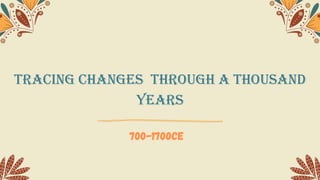Class 7 - Tracing changes through a thousand years
•Download as PPTX, PDF•
0 likes•125 views
Published By Ericsan
Report
Share
Report
Share

Recommended
Recommended
More Related Content
What's hot
What's hot (18)
Architecture of Indus Valley Civilisation & Vedic Era

Architecture of Indus Valley Civilisation & Vedic Era
WH Chapter 2 early river valley civilizations, 3500 b.c. 450 b.c.

WH Chapter 2 early river valley civilizations, 3500 b.c. 450 b.c.
Similar to Class 7 - Tracing changes through a thousand years
Similar to Class 7 - Tracing changes through a thousand years (19)
Class 7th- Tracing changes through a thousand years

Class 7th- Tracing changes through a thousand years
Ch 1 Tracing Changes through a thousand Years 1.pdf

Ch 1 Tracing Changes through a thousand Years 1.pdf
Urbanization Of Ancient Mesopotamia, Egypt And The Indus...

Urbanization Of Ancient Mesopotamia, Egypt And The Indus...
Indus valley civilization (in view of Islamic perspective)

Indus valley civilization (in view of Islamic perspective)
Why Did The Indus Valley Have An Advanced Civilization

Why Did The Indus Valley Have An Advanced Civilization
Recently uploaded
Recently uploaded (20)
dusjagr & nano talk on open tools for agriculture research and learning

dusjagr & nano talk on open tools for agriculture research and learning
HMCS Vancouver Pre-Deployment Brief - May 2024 (Web Version).pptx

HMCS Vancouver Pre-Deployment Brief - May 2024 (Web Version).pptx
This PowerPoint helps students to consider the concept of infinity.

This PowerPoint helps students to consider the concept of infinity.
Simple, Complex, and Compound Sentences Exercises.pdf

Simple, Complex, and Compound Sentences Exercises.pdf
HMCS Max Bernays Pre-Deployment Brief (May 2024).pptx

HMCS Max Bernays Pre-Deployment Brief (May 2024).pptx
General Principles of Intellectual Property: Concepts of Intellectual Proper...

General Principles of Intellectual Property: Concepts of Intellectual Proper...
Class 7 - Tracing changes through a thousand years
- 1. Tracing changes through a thousand years 700-1700CE
- 2. The period from A.D. (CE) 700 to 1200 and from A.D. (CE) 1200 to 1700 are classified as Early Medieval and Later Medieval periods, respectively,
- 3. CHANGES IN THE CARTOGRAPHY TECHNOLOGY
- 4. The first map was made by an Arab cartographer, Al-Idrisi in 1154CE. the second map was made by French cartographer in 1720s. The difference in these map shows the development of Cartography over years. When historians study history, they should be careful because the word which we use today, may have different meaning in the past.
- 5. A simple term like “foreigner” is used today to mean someone who is not an Indian. In the medieval period, a “foreigner” was any stranger who appeared in a given village, someone who was not a part of that society or culture. (In Hindi the term pardesi might be used to describe such a person and in Persian, ajnabi.) CHANGES IN TERMINOLOGY
- 6. Historians and their Sources The use of paper in Medieval era increased when compared to ancient history. Now, the historians need to study both the archaeological sources and various written sources. studying written sources is not a easy task. Written records may be inaccurate and sometimes contain errors. these errors may happen when manuscripts/chronicles were revised or while coping the manuscripts. so historians need to refer many sources to study the medieval history.
- 7. Historians and their Sources EXAMPLE 14th-century chronicler Ziyauddin Barani wrote his chronicle first in 1356 and another version two years later which differ from each other. But historians did not know about the existence of the first version until the 1960s as it remained lost in large library collections.
- 8. Migrating people from all over the world settled in the Indian subcontinent because of the rich resources and minerals available here. These people interacted with each other, which led to advancement in technology.
- 9. Agriculure developed and people cut down forest to make way farm lands. Many forest-dwellers migrated and those who remained started to till their lands and became peasants. With the change in society, people grouped into jatis or sub-castes and were ranked on the basis of their backgrounds and their occupations. Rules and Regulations to manage the conduct of members were framed by Jatis and enforced by an assembly of elders, which also came to be known as jati panchayat. However, jatis also had to follow the rules of the villages. Several villages were governed by a chieftain.
- 10. Islam came to the subcontinent from the Northwest in the seventh century. Quran is the holy book of Muslims. Islam was interpreted in a variety of ways by its followers. There were the Shia Muslims who believed that the Prophet Muhammad’s son-in-law, Ali, was the legitimate leader of the Muslim community, and the Sunni Muslims who accepted the authority of the early leaders (Khalifas) of the community, and the succeeding Khalifas. ISLAM
- 11. Brahmanas earned respect in the society for their knowledge of Sanskrit texts and their dominant position was consolidated by the support of their patrons– new rulers searching for prestige. Another major development of this period was the emergence of the idea of bhakti
- 12. The British historians divided the Indian history on the basis of the religion of the rulers. BRITISH AGE HINDU AGE MUSLIM AGE
- 13. But later historians thought that division only on the basis of religion is not enough. so they divided the Indian history as • Ancient • Medieval • Modern